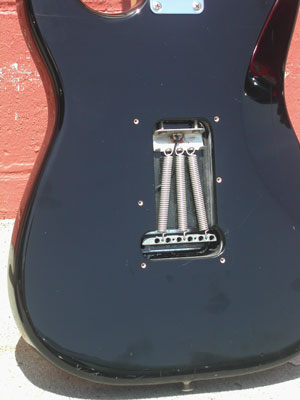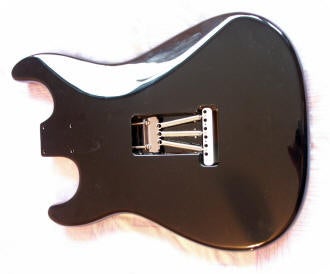The springs in the back of an electric guitar balance the tension of the strings. They are crucial for the tremolo system’s functionality.
Electric guitars often include a fascinating mechanical feature known as the tremolo system, which permits guitarists to add vibrato to their playing by altering the tension of the strings. Located in the guitar’s rear cavity, the springs counteract the pull of the strings when the tremolo arm is used, allowing the guitar to return to its original tuning.
This feature is particularly common in models such as the Fender Stratocaster, where the use of the whammy bar for pitch effects is integral to its iconic sound. Precision in the setup and adjustment of these springs is important, as they can significantly affect the instrument’s playability and tuning stability.
Introduction To Electric Guitar Springs
The soulful bends, the vigorous tremolo dives, and the subtle vibrato—that quintessential magic wielded by electric guitar virtuosos—isn’t conjured by fingers alone. Hidden within the guitar’s structure lies a component often overlooked but essential: the electric guitar springs. These springs are vital for maintaining tension, stability, and facilitating the dynamic use of a tremolo system, enabling artists to express nuances in their sound. Let’s dive into the world of electric guitar springs and discover their unsung role in musical expression.
Understanding The Function Of Guitar Springs
Guitar springs are mechanical components that are crucial for the function of the tremolo or whammy bar. The main job of these springs is to counterbalance the tension of the guitar strings, allowing the tremolo system to return to its original position after use. This ensures that the guitar remains in tune after performing dramatic pitch bends. Without these springs, the tremolo system would be unreliable and could lead to a guitar that sounds off-pitch or out of tune.
The Types Of Springs Used In Electric Guitars
Electric guitars typically utilize two main types of springs:
- Tremolo Springs: Connected to the tremolo block, these springs balance string tension and enable the tremolo bar to function properly.
- Pickup Springs: Small springs found under the pickups help to adjust the height of the pickups, affecting the output volume and tone.
Placement And Role Of Springs In Guitar Design
The placement of guitar springs is critical for performance. Tremolo springs are located in the back cavity of a guitar and attached to a metal block. This block is, in turn, connected to the tremolo system on the front of the guitar body. The number and tension of these springs can be adjusted for a player’s preference, which affects the feel and response of the tremolo system. Pickup springs sit between the guitar’s body and the pickups, allowing for precise height adjustment to tailor the guitar’s tone.

Credit: www.dummies.com
The Mechanics Of Tremolo Systems
An integral part of an electric guitar’s voice and versatility is the tremolo system, often known as a whammy bar. Not to be confused with vibrato, which modulates pitch, tremolo adjusts volume. Guitarists leverage this system to create the expressive dips and rises in pitch that can make a piece distinctive. At the heart of this system lie the springs you can find in the back cavity of the guitar, which are pivotal to both the functionality and stability of the tremolo.
How Springs Influence Tremolo Stability
The springs in the back of an electric guitar work against the tension of the strings, providing a counterbalance that allows the tremolo to return to its original position. Their responsiveness and tension play a crucial role in maintaining tuning stability. A well-balanced tremolo system means fewer tuning issues and a smoother operation during use.
Balancing String Tension With Tremolo Springs
- The number of springs and their tension must offset the pull of the strings.
- Most guitars come standard with three springs, allowing for a solid middle ground in tension.
- Heavier gauge strings might require additional springs, or adjusting tension for balance.
By tweaking the spring configuration, players can ensure that their tremolo system reacts predictably and remains in tune, regardless of whammy bar usage.
Adjusting The Tremolo Springs For Desired Action
Seasoned guitarists often customize the action of their tremolo systems by adjusting the tremolo springs. This might involve changing the number of springs or altering the tension by adjusting the screws at the back of the guitar.
| Action Preference | Spring Adjustment |
|---|---|
| Lighter Touch | Loosen springs slightly |
| Heavier Feel | Tighten springs or add more |
These adjustments lead to a personalized feel of the tremolo system, enabling players to fine-tune their instrument’s response to their playing style.
Maintenance And Customization
Guitar enthusiasts know that the springs in the back of an electric guitar play a crucial role in the functionality and feel of their instrument. Regular maintenance and personalized customization of these springs can significantly enhance your guitar’s performance and tailor its playability to your preferences. Getting to know when to adjust or replace the springs, customizing the spring tension, and troubleshooting common issues can help you keep your instrument in top condition and ensure you get the best experience out of your play sessions.
When To Replace Or Adjust Your Guitar’s Springs
Understanding the right time to replace or adjust your guitar’s springs is paramount for maintaining optimal performance. Signs that it’s time for a change include:
- Inconsistent tuning stability
- Difficulty with the tremolo system
- Visible wear and tear
Regular checks every few months can help prevent these issues and ensure your guitar remains responsive and reliable.
Customizing Spring Tension For Personal Play Style
Guitar spring tension affects the feel of the tremolo system and can be customized to suit your playing style. Whether you prefer a looser feel for easier vibrato or a stiffer setup for greater stability, adjusting the spring tension can make all the difference. To personalize your guitar’s response, experiment with the number of springs and their tension by:
- Adding or removing springs
- Tightening or loosening the spring claw
These adjustments can help create the perfect balance for your desired touch and technique.
Common Issues And Troubleshooting Spring-related Problems
Even with proper maintenance, you might encounter spring-related problems. Here are some common issues and quick fixes:
| Issue | Troubleshooting Tip |
|---|---|
| Spring Noise | Apply lubricant or replace with noiseless springs. |
| Uneven Tremolo Balance | Adjust the spring claw screws for equal tension. |
| Buzzing Strings | Check for loose springs and secure if necessary. |
A proper understanding of these solutions can keep you prepared for any spring-related quandaries you may face.

Credit: m.youtube.com
Springs And Guitar Tone
When delving into the intricacies of electric guitar hardware, the springs in the back of the instrument may not immediately command attention. Yet, these seemingly minor components play a vital role in crafting the guitar’s overall sonic signature. Let’s unravel the mystery of how springs influence an electric guitar’s tone, sustain, and resonance.
The Impact Of Springs On Sustain And Resonance
The springs commonly found in an electric guitar’s tremolo system are essential for maintaining tension and balance when the tremolo arm is used. Their impact on sustain and resonance can be significant. Sustain refers to the length of time a note lingers before it fades away, while resonance determines the richness and quality of the sound.
- Longer springs tend to absorb some of the vibrations, potentially reducing sustain.
- Shorter, tighter springs, on the other hand, may contribute to a more immediate and pronounced note attack, enhancing sustain.
- The number of springs and their tension can also affect the transfer of vibrations from the strings to the guitar body, altering resonant qualities.
Exploring The Myth: Do Springs Really Affect Tone?
The debate continues on whether springs actually influence the tone of an electric guitar. Some guitarists swear by the subtle changes springs can bring, while skeptics suggest the effect is minimal or placebo. Material science and mechanical properties do contribute to tonal variations at a nuanced level, suggesting there is truth behind the claims.
Steel springs can resonate, contributing to the “spring reverb” effect within the guitar cavity, potentially coloring the tone. However, the degree to which this affects the plugged-in sound may vary based on amplifier, effects, and the guitar’s construction.
Choosing The Right Springs For Tone Optimization
Selecting the proper springs for your electric guitar can indeed lead to tone optimization. Here are some key considerations:
| Spring Characteristic | Tonal Influence |
|---|---|
| Spring Tension | Affects string response and can tailor the guitar’s resonance. |
| Spring Length | Longer springs may decrease sustain but increase the warmth of tones. |
| Spring Material | Different metals can slightly color the tone through their inherent resonance properties. |
Experimenting with varying spring setups can help you achieve the desired balance between sustain and resonance. Always consider the compatibility of springs with your tremolo system and personal playing style for the best results.

Credit: www.strat-talk.com
How Do the Springs in the Back of an Electric Guitar Affect the Lever’s Function?
The springs in the back of an electric guitar play a crucial role in the functionality of the lever. By balancing tension and allowing smooth movement, they enable precise control over pitch and effects. For musicians, understanding electric guitar levers is essential for achieving the desired sound and performance.
Frequently Asked Questions Of What Are The Springs In The Back Of An Electric Guitar
Why Are There Springs In An Electric Guitar?
Electric guitar springs balance tension in the tremolo bridge, enabling pitch control while maintaining string stability and tuning accuracy.
What Happens If You Take A Spring Off Of Your Guitar?
Removing a spring from your guitar will lower the tension on the strings, affecting tuning stability and potentially altering the instrument’s action and intonation. Playability and overall sound quality may suffer as a result.
How Many Springs Does An Electric Guitar Have?
An electric guitar typically has one to six springs in the tremolo system, but guitars without tremolos have no springs.
What Is On The Back Of An Electric Guitar?
On the back of most electric guitars, you’ll find the cover for electronics, which houses the wiring for pickups and controls. Some models have a panel to access the tremolo system, and recessed cavities to accommodate added components or weights.
Conclusion
Understanding electric guitar springs is crucial for any guitarist aiming to maintain their instrument’s peak performance. These small components have a big impact on your guitar’s vibrato stability and overall sound. Remember, a well-adjusted spring can make all the difference in achieving that perfect pitch and tone harmony.
Keep strumming and stay in tune!
